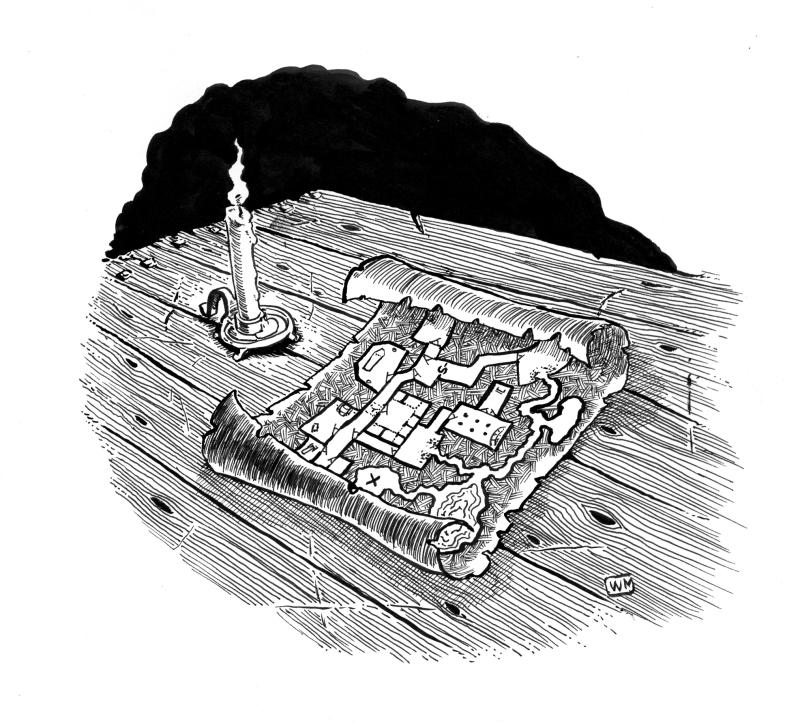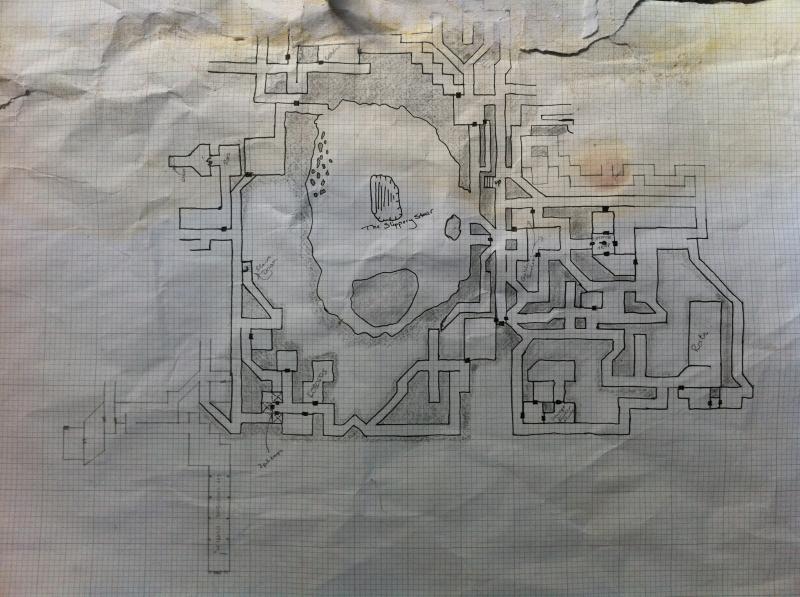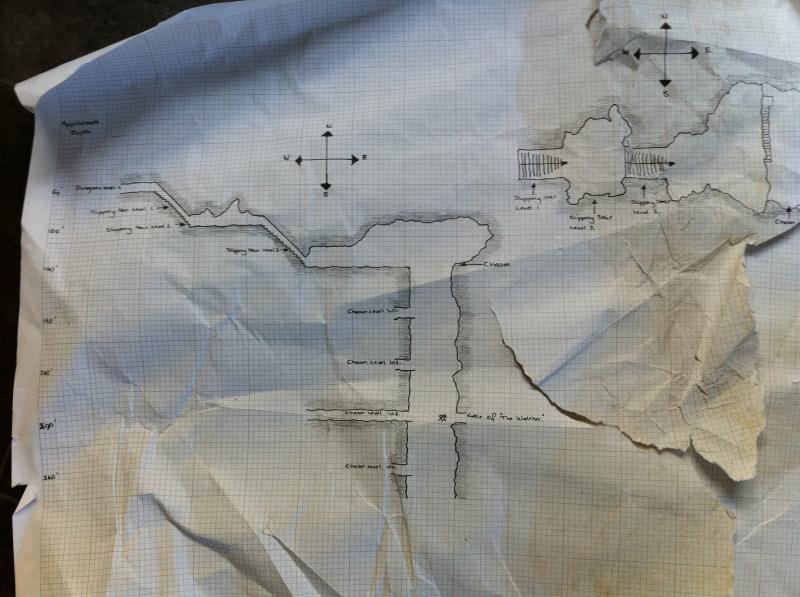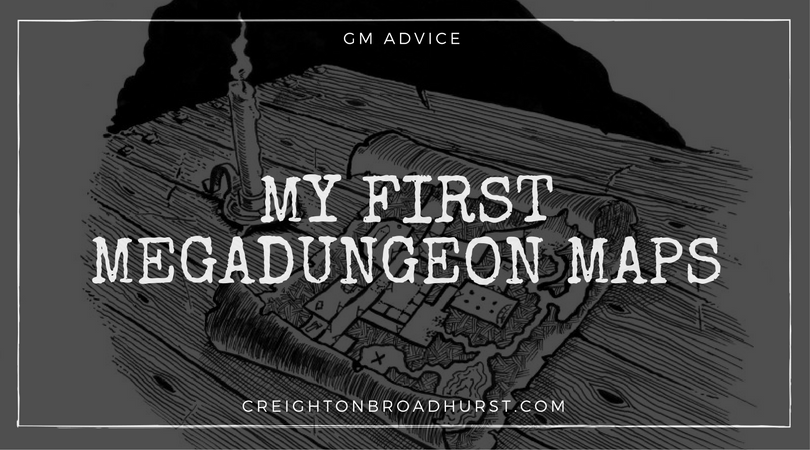One of the key components of a megadungeon is its physical layout. Megadungeons sport many different levels and sub-levels and thus having a decent map is crucial to facilitate play.

Shockingly, given how much time I’ve spent pondering about and designing Gloamhold, I’ve been thinking about megadungeon map design quite a lot in recent weeks
Then, I remembered I had already designed a megadungeon back in the good old days.
Before I got involved in Living Greyhawk, I ran some shop-based games for the RPGA in Torquay. At the time, we had a vibrant gaming scene in Torquay. To facilitate play, I designed a megadungeon called Deep Delve and ran a weekly campaign in the shop. We pinned some large maps up on the walls and updated them after each session. With multiple adventuring parties and a couple of GMs we made good progress through the complex. I can’t remember why the campaign ended or how far we got and sadly over time I’ve lost most of the maps.
However, a couple of years ago I found two maps in the attic and took photos for posterity. Given my recent postings about Gloamhold and megadungeons, I though it would be fun to post up the players’ versions here (because I don’t have the GM’s versions anymore). The graph paper is A0 size, so as you can see we were digging in for a long campaign! One of the requirements of a megadungeon is for the levels to be really big; using A0 paper enabled me to fulfil that requirement and when I do my roughs for Gloamhold I’ll probably do the same again.
The photos below show a section of the player’s map of level 1 as it stood when the campaign ended.

One of the main features of level 1, was a deep chasm known as the Slippery Stair. It linked most of the levels together and was relatively easy to traverse. Using it, the players could access most levels of the dungeon (but sensibly they didn’t go too far down).

As I’ve previously said, the maps aren’t complete and as I recall the players got down to at least level 4 before the campaign ended. Sadly, I’ve lost the GM maps – as you can see these maps are ripped and water stained; the other maps in the roll were badly damaged couldn’t be saved. In any event, I hope you enjoyed this snapshot of the Deep Delve.
Got Maps?
Have you played in a megadungeon of your GMs own design? Have you got maps to share? If they are online leave a link below – I’d love to take a look!

My megadungeon was an island. Not knowing any better, I drew the map 50 feet to a square, so the entire map was something like seven rolls of five sheets taped together vertically.
http://www.hoboes.com/RPG/strata/Mordol/
Do the levels in a megadungeon need to be large? I realize the megadungeon as a whole is (otherwise it’s not a megadungeon), and that a large dungeon with a small number of regions means each region should be large, but ‘large levels’ suggests relatively two-dimensional thinking.
I favor having regions with more vertical elements. In my node-based megadungeon the various regions can be described as ‘suitable for several character levels’ (i.e. a range of threat difficulties within each region, and the ranges change between regions; the Abandoned Tower is probably much more survivable for low-level characters than the Aboleth Conclave Outpost).
The Abandoned Tower? Obviously multiple levels, and they are small. The Wolf Den is arguably mostly one level (many dens and caves all accessible from the ‘same level outside’, as it were). The Clockwork Hell and the route down from the Abandoned Tower are all over the place vertically (many levels) but not always big levels. Ditto the Dwarven Safehold, but the Aboleth Conclave Outpost is arguably a large level (underwater lake surface as ‘baseline’) with many areas (buildings, underwater caves, etc.) having further ups and downs.
… I find it pretty cool that I really haven’t done much with the node-based megadungeon in about two years and I still remembered the areas and what they are.
I would recommend the Dungeoneer’s Survival Guide. I actually read it from cover to cover when it came out and thought it quite inspirational.
Richard
I still have my original copy of that book! Thanks for the suggestion.
was that second ed?
First Ed.
Those are beautiful maps, and the name “The Slippery Stair” is excellent!
Thanks, Daniel. I’m crap at mapping so your comments are particularly welcome!
Personally I favor a horizontal sprawl over vertical, though I do add some ups and downs. The last real megadungeon I did was a ruined town and castle. The zones spread north to south, defined by parts of the town, a woodland overtaking the ruins, areas of the castle that remained fairly intact and surrounding natural terrain.
In an homage to the Caves of Chaos the outermost zone was a boggy hollow just off the main road. Nicknamed The Lowlies by adventurers this hollow had actually once been a quarry pit that had been abandoned after the castle fell and then affected by a century of preternatural wild growth and decay fueled by the First World.
The Lowlies in turn had sheer cliff walls, ledges, caves and partially ruined outbuildings from the days of the quarry obscured by the landscape. Many of the regions in this zone were the lair of some low to mid level threat such as the goblins in the broken masterpiece of dwarves mines called The Howling Step. The impressive edifice of the mine entrance had been so defaced that great scars in the masonry conducted airflow that sounded like distant howling. The door was easily bypassed by design as unwary trespassers interrupted the zephyr and were easily detected.
An entire one year campaign from 1St to 5th level never made it out of the Lowlies.
Your maps are most impressive, Creighton.
Nothing I’ve ever done even comes close to the map you shared with us here.
Thank you, Shawn! I wish my mapping skills were better to be honest, but sadly my sister got all the drawing skills in our generation!